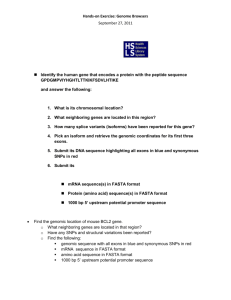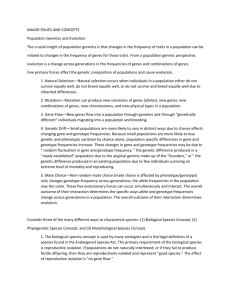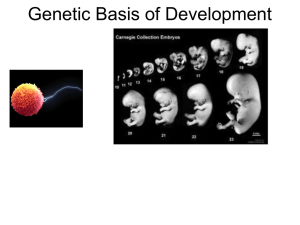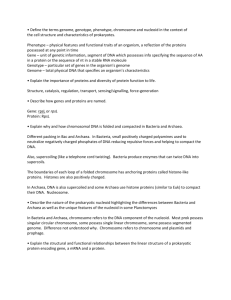Blue genes - genetics - PBL-J-2015
advertisement
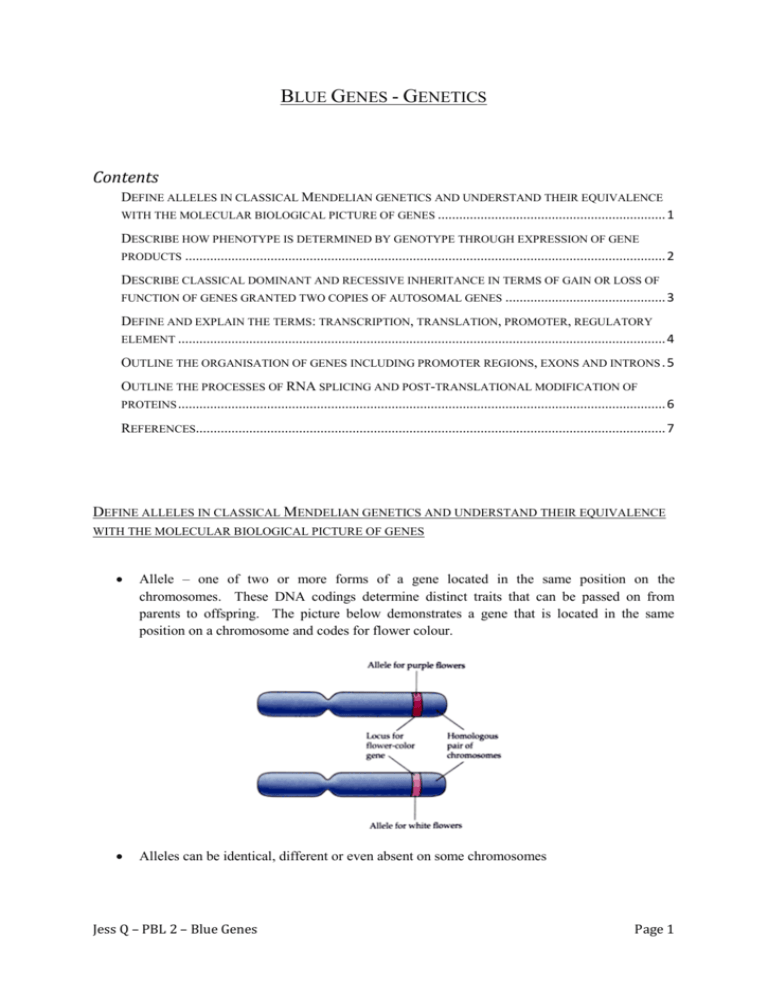
BLUE GENES - GENETICS Contents DEFINE ALLELES IN CLASSICAL MENDELIAN GENETICS AND UNDERSTAND THEIR EQUIVALENCE WITH THE MOLECULAR BIOLOGICAL PICTURE OF GENES ................................................................ 1 DESCRIBE HOW PHENOTYPE IS DETERMINED BY GENOTYPE THROUGH EXPRESSION OF GENE PRODUCTS ....................................................................................................................................... 2 DESCRIBE CLASSICAL DOMINANT AND RECESSIVE INHERITANCE IN TERMS OF GAIN OR LOSS OF FUNCTION OF GENES GRANTED TWO COPIES OF AUTOSOMAL GENES ............................................. 3 DEFINE AND EXPLAIN THE TERMS: TRANSCRIPTION, TRANSLATION, PROMOTER, REGULATORY ELEMENT ......................................................................................................................................... 4 OUTLINE THE ORGANISATION OF GENES INCLUDING PROMOTER REGIONS, EXONS AND INTRONS . 5 OUTLINE THE PROCESSES OF RNA SPLICING AND POST-TRANSLATIONAL MODIFICATION OF PROTEINS ......................................................................................................................................... 6 REFERENCES.................................................................................................................................... 7 DEFINE ALLELES IN CLASSICAL MENDELIAN GENETICS AND UNDERSTAND THEIR EQUIVALENCE WITH THE MOLECULAR BIOLOGICAL PICTURE OF GENES Allele – one of two or more forms of a gene located in the same position on the chromosomes. These DNA codings determine distinct traits that can be passed on from parents to offspring. The picture below demonstrates a gene that is located in the same position on a chromosome and codes for flower colour. Alleles can be identical, different or even absent on some chromosomes Jess Q – PBL 2 – Blue Genes Page 1 Many of the traits that people have are controlled by more than one loci. For example, eye colour is controlled by at least three loci, hair colour is controlled by several loci (different from the eye colour loci) and skin colour is controlled by different loci again. DESCRIBE HOW PHENOTYPE IS DETERMINED BY GENOTYPE THROUGH EXPRESSION OF GENE PRODUCTS Phenotype is determined by genotype based on how dominantly genes are expressed. An example of this is hair colour. Hair colour is caused by a pigment called melanin that comes in two primary forms: eumelanin (which is black or brown) and pheomelanin (which is red or yellow). The colour of a person’s hair is determined by two factors: 1. The amount of melanin produced (more melanin causes darker hair; less melanin causes lighter hair) Jess Q – PBL 2 – Blue Genes Page 2 2. The relative amounts of eumelanin compared with pheomelanin (more eumelanin produces black or brown hair; more pheomelanin produces red or yellow hair) Thus, the degree that a gene is express determines a person’s phenotype. DESCRIBE CLASSICAL DOMINANT AND RECESSIVE INHERITANCE IN TERMS OF GAIN OR LOSS OF FUNCTION OF GENES GRANTED TWO COPIES OF AUTOSOMAL GENES This is an example of classic Mendelian genetics; Consider eye colour where B is dominant to b; and B codes for brown eyes Two dominant homozygous genotypes: B B BB B BB Genotype: BB = 100% B BB BB Phenotype: All brown eyes (100%) One heterozygous genotype and one dominant homozygous genotype: B b B BB Bb B BB Bb Genotype: BB = 50%; Bb = 50% Phenotype: All brown eyes (as both BB and Bb result in brown eye colour) Two heterozygous genotypes: B b B BB Bb b bB Bb Genotype: BB = 25%; Bb = 50%; bb = 25% Phenotype: 75% brown eyes (BB and Bb), 25% blue eyes (bb) Two homozygous recessive genotypes: b b bb b bb Genotype: bb = 100% b Bb Bb Phenotype: All blue eyes (100%) Jess Q – PBL 2 – Blue Genes Page 3 DEFINE AND EXPLAIN THE TERMS: TRANSCRIPTION, TRANSLATION, PROMOTER, REGULATORY ELEMENT The basic concept: DNA (store of information in genes) Transcription RNA (Intermediate carrier of information messenger RNA) Translation Protein (Product of expression of information protein) Transcription = the synthesis of mRNA from a DNA template. It occurs within the nucleus. The steps to transcription are: 1. 2. 3. 4. Enzymes identify the right part of the DNA molecule to transcribe The DNA molecule is opened up to make the message accessible Enzymes build the mRNA strand The DNA molecule snaps shut to release the newly synthesised mRNA Translation = synthesis of a protein from an mRNA template. The steps to translation are: A ribosome recognises an mRNA and latches onto its 5’ end. The ribosome attaches to the mRNA and looks for codons that form the words of the genetic code beginning with the start codon (AUG) 2. tRNAs supply the amino acids dictated by each codon when the ribosome reads the instructions. The polypeptide chain is assembled by the ribosome with the help of various enzymes and proteins. 3. The ribosome continues to assemble the polypeptide chain until it reaches the stop codon (UAA, UAG, UGA). The completed polypeptide chain is released. 1. Promoter = DNA sequence to which RNA polymerase binds. Before a gene of any size can be transcribed, it must be located. The cue that says “start transcription here” is written into the DNA in regions called promoters! The sequence that indicates where to stop transcribing is called a Jess Q – PBL 2 – Blue Genes Page 4 terminator. The combination of the gene, the promoter and the terminator is called the transcription unit. In eukaryotes the sequence of the promoter is always the same and is called the TATA box because the sequence of bases is TATAAA. Regulatory Element = (control element) = regions of DNA to which regulatory proteins bind; regulates gene transcription. Regulatory elements affect the expression of sequences to which they are physically linked. The regulation of gene expression can be through processes that stimulate gene expression, termed positive control, or through processes that inhibit gene expression, termed negative control. OUTLINE THE ORGANISATION OF GENES INCLUDING PROMOTER REGIONS, EXONS AND INTRONS Promoter regions: A specific region just upstream from a gene that acts as a binding site for transcription factors and RNA polymerase during the initiation of transcription Exons: The coding part of a gene. Introns: The noncoding part of a gene. Intervening sequences that intersperse exons Jess Q – PBL 2 – Blue Genes Page 5 OUTLINE THE PROCESSES OF RNA SPLICING AND POST-TRANSLATIONAL MODIFICATION OF PROTEINS RNA splicing When genes are transcribed, both exons and introns are copied into mRNA. The mRNA transcript is then edited (i.e.: the introns are removed) in preparation for translation When multiple introns are present in the unedited transcript, various combinations of exons can result from the editing process. Exons can be edited out too, yielding new proteins when translation does occur. As one gene can code for more than one protein, genetic variations are seen Posttranslational modification: Alteration of a protein after translation; may also include cleavage from a larger precursor protein, the removal of amino acids, and the attachment of other molecules to the proteins. A number of different types of modifications are possible. Some include: Synthesis of proteins into larger precursor proteins Attachment of carbohydrates to make the proteins functional Folding of proteins Removal of signal sequence (signal sequence ‘directs’ the protein to a specific location within a cell) Jess Q – PBL 2 – Blue Genes Page 6 REFERENCES Nb: books are all from the uni library Lister Hill National Centre for Biomedical Communications. (2012). Retrieved 19 February, 20120 from http://ghr.nlm.nih.gov. Pierce, B. (2008). Genetics: A Conceptual Approach (Third Edition). New York. W.H. Freeman and Company. Robinson, T. (2005). Genetics for Dummies. New Jersey: Wiley Publishing. Sherwood, L. (2004). Human Physiology: From Cells to Systems (5th Edition). Australia: Thompson. Willett, E. (2006). Genetics Demystified. New York: McGraw Hill. Lecture notes “Cells and genetics 2”, Dr. Rose Martiniello-Wilks Jess Q – PBL 2 – Blue Genes Page 7
